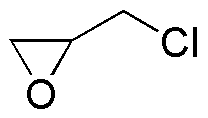(±)-Epichlorohydrin is widely utilized in research focused on various applications across multiple industries.
- Production of Epoxy Resins: This chemical is a key precursor in manufacturing epoxy resins, which are used in coatings, adhesives, and composite materials. These resins are known for their strong adhesion and resistance to chemicals, making them ideal for automotive and aerospace applications.
- Synthesis of Glycerol Ethers: It serves as a building block for synthesizing glycerol ethers, which are used in personal care products and pharmaceuticals. These compounds enhance the texture and stability of lotions and creams.
- Intermediate in Chemical Synthesis: As an important intermediate, it plays a role in the production of various chemicals, including pharmaceuticals and agrochemicals. Its versatility allows for the creation of diverse compounds tailored for specific applications.
- Manufacture of Flame Retardants: It is also used in producing flame retardants that are essential for improving the safety of materials in construction and electronics, providing an added layer of protection against fire hazards.
- Research in Polymer Chemistry: In academic and industrial research, it is utilized to study polymerization processes, helping scientists develop new materials with enhanced properties for various applications, including packaging and insulation.
General Information
Properties
Safety and Regulations
Applications
(±)-Epichlorohydrin is widely utilized in research focused on various applications across multiple industries.
- Production of Epoxy Resins: This chemical is a key precursor in manufacturing epoxy resins, which are used in coatings, adhesives, and composite materials. These resins are known for their strong adhesion and resistance to chemicals, making them ideal for automotive and aerospace applications.
- Synthesis of Glycerol Ethers: It serves as a building block for synthesizing glycerol ethers, which are used in personal care products and pharmaceuticals. These compounds enhance the texture and stability of lotions and creams.
- Intermediate in Chemical Synthesis: As an important intermediate, it plays a role in the production of various chemicals, including pharmaceuticals and agrochemicals. Its versatility allows for the creation of diverse compounds tailored for specific applications.
- Manufacture of Flame Retardants: It is also used in producing flame retardants that are essential for improving the safety of materials in construction and electronics, providing an added layer of protection against fire hazards.
- Research in Polymer Chemistry: In academic and industrial research, it is utilized to study polymerization processes, helping scientists develop new materials with enhanced properties for various applications, including packaging and insulation.
Documents
Safety Data Sheets (SDS)
The SDS provides comprehensive safety information on handling, storage, and disposal of the product.
Product Specification (PS)
The PS provides a comprehensive breakdown of the product’s properties, including chemical composition, physical state, purity, and storage requirements. It also details acceptable quality ranges and the product's intended applications.
Certificates of Analysis (COA)
Search for Certificates of Analysis (COA) by entering the products Lot Number. Lot and Batch Numbers can be found on a product’s label following the words ‘Lot’ or ‘Batch’.
*Catalog Number
*Lot Number
Certificates Of Origin (COO)
This COO confirms the country where the product was manufactured, and also details the materials and components used in it and whether it is derived from natural, synthetic, or other specific sources. This certificate may be required for customs, trade, and regulatory compliance.
*Catalog Number
*Lot Number
Safety Data Sheets (SDS)
The SDS provides comprehensive safety information on handling, storage, and disposal of the product.
DownloadProduct Specification (PS)
The PS provides a comprehensive breakdown of the product’s properties, including chemical composition, physical state, purity, and storage requirements. It also details acceptable quality ranges and the product's intended applications.
DownloadCertificates of Analysis (COA)
Search for Certificates of Analysis (COA) by entering the products Lot Number. Lot and Batch Numbers can be found on a product’s label following the words ‘Lot’ or ‘Batch’.
*Catalog Number
*Lot Number
Certificates Of Origin (COO)
This COO confirms the country where the product was manufactured, and also details the materials and components used in it and whether it is derived from natural, synthetic, or other specific sources. This certificate may be required for customs, trade, and regulatory compliance.


